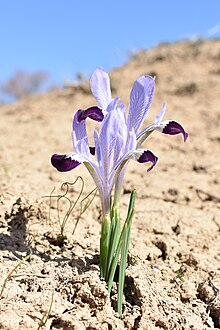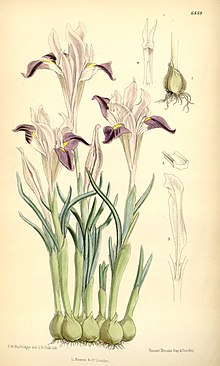Iris kolpakowskiana, or Kolpakowski's iris,[2] is a plant species in the genus Iris, it is classified in the subgenus Hermodactyloides and section Monolepsis. It is a bulbous perennial from Asia.
| Iris kolpakowskiana | |
|---|---|

| |
| Scientific classification | |
| Kingdom: | Plantae |
| Clade: | Tracheophytes |
| Clade: | Angiosperms |
| Clade: | Monocots |
| Order: | Asparagales |
| Family: | Iridaceae |
| Genus: | Iris |
| Subgenus: | Iris subg. Hermodactyloides |
| Section: | Iris sect. Monolepsis |
| Species: | I. kolpakowskiana
|
| Binomial name | |
| Iris kolpakowskiana | |
| Synonyms[1] | |
| |

Description
editIt has a bulb covered with a densely reticulate fibrous tunics.[3]
It has 3–4 leaves,[3] which are similar to many irises of the genus Scorpiris, although it has only a few leaves at flowering time.[4]
They are 3.5–11 cm (1.4–4.3 in) long,[3] and can increase up to 30 cm (12 in) later after flowering.[4] They are 0.2 cm wide and ribbed on the underside.[3]
It has a very short stem, green spathes (leaves of the flower bud) and perianth tube 5–9 cm (2.0–3.5 in) long.[3]
It blooms in late winter,[5] between March,[6] and April.[3]
The flowers are bi-tone (2 coloured),[7] they come in purple shades, from reddish-violet,[7] lilac-violet,[3][8] pale lilac to pale purple.[5]
Like other irises, it has 2 pairs of petals, 3 large sepals (outer petals), known as the 'falls' and 3 inner, smaller petals (or tepals), known as the 'standards'.[9]: 17 The falls are lanceolate shaped, 3.5–4 cm (1.4–1.6 in) long.[3] They are dark violet, purple,[3] or dark reddish purple,[5] with a yellow,[3] or yellow orange ridge.[5][7] The standards are obovate or oblanceolate shaped and 3.5–5 cm (1.4–2.0 in) long.[3]
It has stamens with filaments that are 0.5–0.9 cm long.[3]
After the iris has flowered, it produces a cylindrical with a short beak seed capsule.[3]
Biochemistry
editAs most irises are diploid, having two sets of chromosomes, this can be used to identify hybrids and classification of groupings.[9]: 18 It was counted as 2n=20.[7][3]
Taxonomy
editIt is pronounced as (Iris) EYE-ris (kolpakowskiana) kol-pa-kow-skee-AY-nuh.[2] It is sometimes known as 'Kolpakowski's Iris'.[2]
It is sometimes mis-spelt as Iris kolpakowskyana. It was named after the first Russian military Governor of Semirechye Oblast in modern Kazakhstan Gerasim Alexeevich Kolpakovsky.[10][11][12] See also Sun Tulip or Kolpakowski Tulip.[13]
The iris was first described by Eduard August von Regel in the Botanical Magazine No.6489 in 1880.[5][14]
Iris kolpakowskiana is now an accepted name by the RHS,[15] and was verified by United States Department of Agriculture and the Agricultural Research Service on 2 October 2014.[16]
Distribution and habitat
editIt is native to temperate Asia.[16]
Range
editIt is found in the Tien Shan Mountains, Turkestan.[3][6][7] It is also found in Kazakhstan, Uzbekistan,[16] and Kyrgyzstan.[17]
Habitat
editIt grows on the hillsides,[18] and open grassy slopes,[3] in wet sticky clay that dries out in summer.[19]
It is normally found at 800–3,000 m (2,600–9,800 ft) above sea level,[18] near the melting snowline.[3]
Conservation
editIt was on the 1997 IUCN Red List of Threatened Plants.[20]
References
edit- ^ "Iris kolpakowskiana Regel". theplantlist.org. 23 March 2012. Retrieved 31 October 2014.
- ^ a b c "PlantFiles: Kolpakowski's Tulip". davesgarden.com. Retrieved 24 July 2014.
- ^ a b c d e f g h i j k l m n o p q British Iris Society (1997) A Guide to Species Irises: Their Identification and Cultivation, p. 282, at Google Books
- ^ a b Cassidy, G.E.; Linnegar, S. (1987). Growing Irises (Revised ed.). Croom Helm. pp. 145–146. ISBN 9780709907060.
- ^ a b c d e Walters, Stuart Max (Editor) European Garden Flora: A Manual for the Identification of Plants Cultivated, p. 354, at Google Books
- ^ a b Richard Lynch The Book of the Iris, p. 164, at Google Books
- ^ a b c d e Kramb, D. (25 September 2004). "Iris aphylla". signa.org (Species Iris Group of North America). Retrieved 18 February 2018.
- ^ Lyte, Charles (17 March 2001). "In focus: iris reticulata". Daily Telegraph. Retrieved 18 February 2018.
- ^ a b Austin, Claire (2005). Irises; A Garden Encyclopedia. Timber Press. ISBN 0-88192-730-9.
- ^ Foster, Prof. Michael (3 May 1892). "Bulbous Irises". Retrieved 16 July 2014.
- ^ "All results for Kolpakowski in Newspaper Archive". myheritage.com. Retrieved 24 July 2014.
- ^ "Победа казаков и казахов". Archived from the original on 2016-02-05. Retrieved 2015-05-22.
- ^ "Kolpakowski Tulip, aka Sun Tulip". www.paghat.com. Retrieved 24 July 2014.
- ^ "Iridaceae Iris kolpakowskiana Regel". ipni.org (International Plant Names Index). Retrieved 31 October 2014.
- ^ "Iris kolpakowskiana". www.rhs.org.uk. Retrieved 31 October 2014.
- ^ a b c "Iris kolpakowskiana". Germplasm Resources Information Network. Agricultural Research Service, United States Department of Agriculture. Retrieved 22 August 2015.
- ^ Sasha W. Eisenman, David E. Zaurov, Lena Struwe Medicinal Plants of Central Asia: Uzbekistan and Kyrgyzstan: Uzbekistan and Kyrgyzstan, p. 5, at Google Books
- ^ a b "Iris kolpakowskiana". www.alpinegardensociety.net. 2013. Retrieved 24 July 2014.
- ^ "Reticulata Irises". www.pacificbulbsociety.org. 11 May 2014. Retrieved 14 July 2014.
- ^ Kerry Scott Walter, Harriet J. Gillett (Editors) 1997 IUCN Red List of Threatened Plants, p. 679, at Google Books
Other sources
edit- Czerepanov, S. K. 1995. Vascular plants of Russia and adjacent states (the former USSR). (referred to as Iridodictyum kolpakowskianum (Regel) Rodion)
- Komarov, V. L. et al., eds. 1934–1964. Flora SSSR.
- Mathew, B. 1981. The Iris. 177.
External links
edit- Media related to Iris kolpakowskiana at Wikimedia Commons
- Data related to Iris kolpakowskiana at Wikispecies